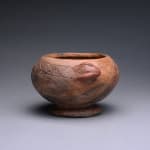Bahia Terracotta Bowl, 200 BCE - 600 CE
Terracotta
height 8.9 cm
height 3 1/2 in
height 3 1/2 in
PF.2613
Further images
The Pre-Columbian cultures of Ecuador are among the oldest in South America and among the first to master the art of pottery. Although we know little about the peoples themselves...
The Pre-Columbian cultures of Ecuador are among the oldest in South America and among the first to master the art of pottery. Although we know little about the peoples themselves or their traditions, historians have been able to piece together a picture of life in Ancient Ecuador thanks in part to the art and artifacts left behind. The culture of Valdivia created some of the oldest known works of art in the Americas. Situated along the coastal strip of Ecuador, the Valdivians established a thriving society that flourished for around two thousand years (from approximately 4000 to 1500 B.C.). Today they are famed for their small fertility figures, believed to be the earliest representational works of art in the Americas, first carved from stone, later formed from terracotta.
Hundreds of years later after the Valdivians disappear from the archaeological record appears another culture to which the name Chorrera has been attached (lasting from circa 1100-300 B.C.). Little is known about this culture; however, it is significant for its widespread geographical reach. As such, their artistic style greatly influenced those diverse cultures that began to emerge in the final centuries of the Chorrera period, a time historians have labeled the Period of Regional Development.
Among the most prominent cultures that flourished in the wake of the Chorrera are the cultures of Bahia, Jama Coaque, and La Tolita. Around 200 B.C., the Bahia developed along the coastal strip in the modern province of Manabi, lasting until approximately 600 A.D. Their earliest terracotta works were greatly indebted to the Chorrera; however, over the years a distinctive style emerged characterized by large figures adorned with detailed dress and body ornamentation.
Here we see the results of a skilled Ecuadorian potter whose ceramic techniques and aesthetic sensibilities combine to create a bowl of dramatic line and proportion. A softly swelling body rises from the base, its curving lines incorporating the meandering figure of a snake, whose head rises in triumph from the side of the bowl. As we peer inside the bowl we are surprised to note that the bottom has been left open. Perhaps, as a funeral vessel, the punctured space at the bottom of the bowl allows for the soul of the deceased to rise upward into the heavens, in a tradition not unlike that of the Ancient Indians of the American Southwest. Whatever the function of this extraordinary vessel, we are captivated by its spirited beauty and appreciative of the outstanding craftsmanship that is involved in creating such a unique work of Ancient Ecuadorian ceramic art.
Hundreds of years later after the Valdivians disappear from the archaeological record appears another culture to which the name Chorrera has been attached (lasting from circa 1100-300 B.C.). Little is known about this culture; however, it is significant for its widespread geographical reach. As such, their artistic style greatly influenced those diverse cultures that began to emerge in the final centuries of the Chorrera period, a time historians have labeled the Period of Regional Development.
Among the most prominent cultures that flourished in the wake of the Chorrera are the cultures of Bahia, Jama Coaque, and La Tolita. Around 200 B.C., the Bahia developed along the coastal strip in the modern province of Manabi, lasting until approximately 600 A.D. Their earliest terracotta works were greatly indebted to the Chorrera; however, over the years a distinctive style emerged characterized by large figures adorned with detailed dress and body ornamentation.
Here we see the results of a skilled Ecuadorian potter whose ceramic techniques and aesthetic sensibilities combine to create a bowl of dramatic line and proportion. A softly swelling body rises from the base, its curving lines incorporating the meandering figure of a snake, whose head rises in triumph from the side of the bowl. As we peer inside the bowl we are surprised to note that the bottom has been left open. Perhaps, as a funeral vessel, the punctured space at the bottom of the bowl allows for the soul of the deceased to rise upward into the heavens, in a tradition not unlike that of the Ancient Indians of the American Southwest. Whatever the function of this extraordinary vessel, we are captivated by its spirited beauty and appreciative of the outstanding craftsmanship that is involved in creating such a unique work of Ancient Ecuadorian ceramic art.











